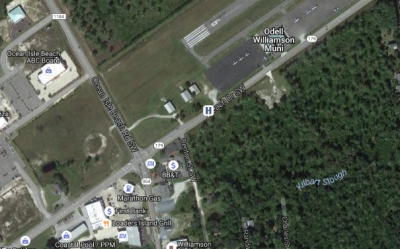OCEAN ISLE BEACH – A request to fill wetlands as part of a large commercial development here is up for public review.
Atlanta-based Halpern Development Co. LLC is seeking approval from the Army Corps of Engineers to fill a little more than two acres of about five acres of federally regulated wetlands on a nearly 45-acre site at the intersection of Causeway Drive and Beach Drive on the mainland side of Ocean Isle Beach.
Supporter Spotlight

Halpern acquires, develops, leases and manages shopping centers as long-term investments.
Construction of the proposed Ocean Isle Beach Marketplace would also affect 114 feet of perennial stream, 38 feet of intermittent stream and 205 feet of non-stream tributaries to make way for a large grocery store, retail shops and parking, according to the application submitted to the Corps.
“It’s a large chunk of wetlands,” said Chad Coburn, senior environmental specialist with the North Carolina Department of Environmental Quality’s Division of Water Resources. “They’re all part of one wetland complex, but they’re all in different places. The impacts are in different places. There’s one for a road, one for a shop, one for a grocery store. The majority’s for a parking lot and a restaurant.”
To offset the damaging effects of the project, the developer would buy wetland and stream credits from the Stone Farm Regional Mitigation Bank, a 1,400-acre site just east of Calabash in Brunswick County.
This process is required under the federal Section 404 of the Clean Water Act.
Supporter Spotlight
“They have to mitigate for how much they impact,” Coburn said. “Usually on smaller projects, the Corps will ask them to buy two-to-one. In this case it looks like they’re buying in for all of their impacts.”

The applicant has proposed to purchase credits at a 1:1 ratio and plans to buy about a third of an acre of riparian wetland, wetlands adjacent to streams, credits, 1.7 acres of non-riparian wetland credits, and 152 feet of stream credits.
The Stone Farm mitigation site includes streams and wetlands damaged by more than 100 years of agricultural and forestry management practices. The land is adjacent to the Little Caw Caw Canal in the lower Lumber River basin.
Restoration plans for Stone Farm include 300 acres of wetlands and more than 20,000 feet of streams.
Mitigation banks were first established in the early 1980s as a way to reduce wetlands and streams damage that resulted from states’ transportation and other government-led projects.
Restoring the same type of wetlands within the same basin theoretically equates to zero net loss of wetlands.
The more than 4.5 acres of 404 wetlands in the middle of the site of the proposed marketplace development flow to Kilbart Slough, a stream that runs into the Atlantic Intracoastal Waterway.
The stream is classified by the Division of Water Resources as “SA,” a designation given to tidal salt waters used for commercial shell fishing or marketing purposes. Kilbart Slough is also listed as High Quality Waters, or HQW, which are rated “excellent” based on their biological, physical and chemical characteristics.
The Corps has determined that the project would not affect essential fish habitat or federally endangered species.
The developer’s application to the Corps does not include a certification that work on the proposed development would be consistent with the North Carolina Coastal Zone Management Program. This certification must be submitted to the Corps and state Division of Coastal Management before a federal permit may be issued.

On-site mitigation effects include the installation of a culvert to maintain water flow, construction of headwalls, or retaining walls at the culvert outlets, to minimize effects on streams, and development of a stormwater, sedimentation and erosion control plan.
Coburn said he’s walked the entire length of both the perennial and intermittent streams on the land, which is planned as the site for a Publix grocery store and other retail shops.
Under the proposed plans, the longer perennial stream that would be affected on the property would continue to flow through a culvert.
“In general, if culverts are installed correctly and at the proper grade, there’s not as much of an issue,” Coburn said. “My bigger concern is the 38 linear feet of impact on the small, intermittent stream. That’s where the stream begins. The big thing for me is to make sure that stream has water in the future. Why do you need that impact right there where the stream starts? Could you not culvert it?”
Coburn said he will submit his comments and concerns to the Corps following the public comment period.
The Corps is accepting comments from the public on the developer’s application through Oct. 31.







